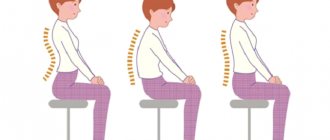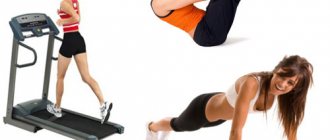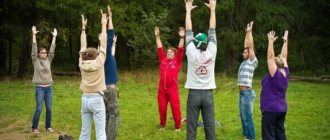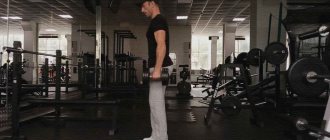During a normal pregnancy, physical activity is as necessary as adequate sleep or good nutrition. That is why expectant mothers are recommended to master special gymnastic complexes that will not only benefit their health, but also help prepare for childbirth.
During pregnancy and childbirth, intra-abdominal pressure increases sharply, and to contain it, you need strong, elastic muscles of the abdominal press and pelvic floor. Women who exercise during pregnancy are much less likely to experience swelling and stretch marks on the skin of the abdomen and thighs.
Regular exercises help develop proper breathing necessary during childbirth, prepare the cardiovascular system for increased stress, increase blood flow to the vessels of the uterus and placenta, which ensures a better supply of oxygen and nutrients to the fetus. Physical training reduces the risk of complications (bleeding, weakness of labor, etc.), helps to recover faster after childbirth. Finally, physical exercise is a powerful psychotherapeutic factor that helps avoid depression during pregnancy and after childbirth.
Physical training skills are also necessary during childbirth, since during the most critical period of childbirth - pushing, the muscles of the woman giving birth are actively involved. One of the skills necessary during childbirth, acquired by performing special exercises for pregnant women, is the ability to tense some muscle groups while completely relaxing others.
When does the risk outweigh the benefit?
Adequate physical activity is necessary not only for healthy pregnant women. Reasonable, dosed exercises are prescribed even to women with serious chronic diseases: diabetes, hypertension, pathology of the kidneys, heart, thyroid gland. However, there are a number of conditions in which any gymnastics is absolutely contraindicated.
These include:
- the presence of acute (for example, ARVI) or exacerbations of chronic (pyelonephritis, gastritis, cholecystitis) diseases;
- the threat of termination of pregnancy at any stage, as well as the presence of miscarriages at this stage of pregnancy in the past;
- bleeding from the genital tract, placenta previa or low-lying placenta;
- early toxicosis of pregnancy, accompanied by vomiting;
- gestosis is a disease of the second half of pregnancy, accompanied by increased blood pressure, edema and the appearance of protein in the urine;
- polyhydramnios.
In addition to established diagnoses, there are signs that, if they appear, you should immediately stop training, and if they appear during each session, then stop doing gymnastics altogether:
- pain in the lower abdomen, constant or cramping;
- increased uterine tone that does not go away immediately after finishing the exercise;
- the appearance of unusual vaginal discharge;
- dizziness, visual impairment;
- difficulty breathing, shortness of breath, pain in the heart area;
- increase in blood pressure more than 140/100 mm Hg. Art. or an increase in heart rate of more than 120 beats per minute during exercise (the heart rate should return to normal 5 minutes after the end of the exercise);
- violent movements of the fetus during training or a long absence of movements after its completion.
Before starting classes, you need to enlist the support of the gynecologist who is observing you.
Exercise for the third trimester
In the third trimester, it is already more difficult for a woman to move, as her stomach grows to a larger size. However, this is not a reason to stop training. If everything is done correctly, they will help prepare for the upcoming birth and make the woman in labor more resilient.
Intense exercise should be avoided. In later stages, preference is given to movements to develop proper breathing and strengthen the muscles of the abdomen, perineum, hips and back. The complex should also include exercises with a fitball. It will make training safer. It will come in handy later during labor.
For comfort and safety during exercise, you can wear a maternity band to support your belly. In addition to training at home, it is recommended to do aqua gymnastics under the supervision of a trainer. If you attend group classes, you can chat with other pregnant women. This will reduce the risk of developing prenatal depression.
Exercise with dumbbells for abdominal and back muscles
How to do it:
- Sit on a fitball, hold dumbbells weighing a maximum of 1 kg in your hands. Lower them along the body.
- Bend your elbows and lift the dumbbells to your armpits. Then slowly return to the starting position.
- Also bending your upper limbs at the elbow joints, bring the dumbbells to your shoulders. Smoothly return to the starting position.
Perform the movements alternately 5-7 times each. During training, make sure that the body remains motionless, breathing is measured and calm.
Exercise to strengthen the muscles of the perineum and thighs
Technique for performing exercises for pregnant women 3rd trimester:
- Lie on the floor, put one leg on the fitball.
- Roll the ball, moving your leg to the side and returning it to its original position. You can also bend the lower limb at the knee to move the fitball.
Do the exercise 3-4 times with each leg.
You can go to fitness centers, a school for expectant mothers, or even go to a swimming pool for free swimming.
Chest exercise
How to do:
- Take the fitball in your hands.
- Extend your limbs forward while continuing to hold the ball.
- Press your palms onto the fitball for a few seconds and relax. The stomach should not tense during the exercise.
The movement is performed 5-10 times.
The problem of choosing activities for pregnant women
The approach to classes should be individual and primarily depend on what level of training you had before pregnancy.
For trained women, the level of physical activity immediately after establishing the fact of pregnancy should be reduced by a third. There are sports that are extremely undesirable to engage in during pregnancy. First of all, these are traumatic sports, all game sports, jumping and vibration, lifting weights over 3 kg and less above the shoulder girdle are also contraindicated. The optimal sports are walking, swimming, and cross-country skiing.
In addition to these classic sports, there are also special techniques adapted for pregnant women.
Gymnastics on a fitball - a large gymnastic ball - trains the sense of balance, coordination of movements, and allows you to train those muscle groups that are not involved in regular exercises. At the same time, the muscles not involved in the exercises remain relaxed, which avoids overwork.
Pilates is a set of exercises for the whole body that develops flexibility and mobility, named after the developer of this system, Joseph Pilates. Exercises strengthen the deep muscles that fix the normal position of the spine and internal organs. These muscles include the paravertebral muscles, abdominal muscles, pelvic floor, and lower back. Thanks to constant training, a woman manages to avoid back pain associated with a shift in the center of gravity of the body with increasing pregnancy. In addition, Pilates helps to increase the extensibility of the perineal tissues, “opening” of the hip joints - relaxing the ligaments, which allows the joint to work in greater amplitude, as well as teaches isolated tension of the abdominal muscles, i.e. skills needed during childbirth.
Yoga. Yoga classes are aimed at developing posture, strengthening and stretching the joint and ligamentous apparatus, as well as restoring psycho-emotional balance and strengthening the nervous system. Yoga improves blood circulation, helps cope with fatigue, swelling, headaches and constipation, and is the basis of any breathing exercises and relaxation techniques. Yoga asanas (special poses) help stretch the spine, relax and stretch the pelvic muscles, strengthen the abdominal muscles, “open” the hip joints, etc.
If you did not exercise regularly before pregnancy (2-3 times a week), then your choice should be special classes for pregnant women: physical therapy, recreational swimming, breathing and relaxation training. The ideal option is individual training with an instructor. Special groups for expectant mothers are more accessible. It is good if the composition of such a group is constant and homogeneous in terms of gestational age.
The approach to classes should be individual and primarily depend on what level of training you had before pregnancy.
During exercise, it is necessary to avoid overheating and dehydration. The training room should be well ventilated, but without drafts, the optimal temperature is about 20ºC. You should avoid training in stuffy and humid areas, as well as dressing too warmly. Proper breathing is of great importance: breathe slowly through your nose, inhale during the tense stage of the exercise, exhale during relaxation. Classes should be carried out two hours after and one hour before meals.
When should pregnant women not exercise?
Many women refuse exercise during pregnancy, considering it dangerous. This may be justified if the pregnant woman is not feeling well. Before you start doing exercises, it is better to consult a specialist .
Physical activity is undesirable in the following cases:
- With severe toxicosis, accompanied by vomiting more than twice a day;
- Toxicosis (preeclampsia) in late pregnancy;
- If a previous pregnancy ended in miscarriage;
- With uterine hypertonicity;
- With a low placenta;
- If there is a threat of miscarriage and bleeding;
- For pain in the abdomen;
- At elevated temperatures, ARVI, diabetes and gastritis.
If the expectant mother feels good and there are no contraindications, you can safely start doing exercises. However, it happens that a few days after the start of classes, a pregnant woman feels discomfort. Then you should refrain from physical activity for a couple of days to listen to your body. Muscles may react this way to stress, especially if you did not exercise before pregnancy. Then it is better to rest, recover, and then return to physical activity again. During pregnancy, you should not put too much stress on yourself, since you are responsible not only for your health, but also for the health of the unborn baby.
When can you exercise during pregnancy?
In the first trimester of pregnancy (up to 12 weeks), unprepared expectant mothers who did not exercise at all or only occasionally exercised before pregnancy should focus on walking, breathing exercises, relaxation, and exercises to strengthen the muscles of the perineum and arch of the foot. The arch of the foot experiences significant stress during late pregnancy, so it is important to prepare it now. At the same time, on the days corresponding to menstruation according to the individual calendar, it is better to avoid any physical activity. At this stage, it is important to exclude exercises on the abdominal muscles.
Physical fitness skills are also necessary during childbirth.
You need to start training gradually, from 10-15 minutes, and your condition should be described by the term “comfortable” - no “I can’t do” exercises. If you have not played sports before, then your first lesson will consist only of a warm-up and a final part. Then gradually add exercises from the main part.
Gymnastic exercises for expectant mothers during various periods of pregnancy
Today, many women are so busy with work or household chores that it is difficult for them to find time to visit the gym or fitness club. In normal times, the fairer sex is recommended to have minor physical activity on the body, but for pregnant women, at least morning exercises and several sets of gymnastic exercises during the day are simply necessary. This will directly affect the health of the unborn baby and the birth process.
Why do pregnant women need moderate exercise?
The majority of expectant mothers who constantly regularly perform physical exercises claim that pregnancy does not provide them with virtually any inconvenience; for the first few months they do not notice any changes in their condition at all, and they do not experience any complications. But those who limit themselves from all this, protect themselves, already from the first trimester begin to feel worse and worse, it becomes more difficult to breathe fully and perform any movements.
Let's list the positive effects on the body from regular gymnastic exercises performed by pregnant women. With their help:
— blood circulation of all organs and tissues of the woman and fetus improves, thanks to which they receive more oxygen and nutrients;
- the pelvic muscles and the muscles surrounding the spinal column are trained and significantly strengthened, and this is an excellent guarantee for a quick and easy birth;
- the likelihood of developing gestosis of pregnancy, constipation, gastroesophageal reflux is reduced, blood stagnation in the superficial veins of the lower extremities is reduced;
— the general tone of the pregnant woman’s entire body increases;
— the elastic properties of muscles and skin are preserved and even improved, weakness and fatigue go away, sleep becomes complete and of high quality;
- the development of obesity is prevented, the respiratory functions of the lungs are trained, which is important for the normal course of future contractions and the birth process itself.
In what cases is exercise contraindicated for pregnant women?
Considering all of the above positive qualities of gymnastics for the expectant mother, we are still obliged to say that each of them must first consult with her attending gynecologist. He, in turn, will decide whether you can perform certain exercises and with what intensity. This question applies most of all to those who did not engage in any type of sports activity before pregnancy. In some conditions, pregnant women are advised to have absolute rest, or even bed rest. These include regular bleeding from the vagina, increased uterine tone, and threatening abortion.
The nature and intensity of physical activity is selected by a specialist depending on the duration of pregnancy, as well as the compensatory capabilities of the expectant mother’s body. It should also be noted that contraindications to certain loads may disappear in the first trimester, for example, in the second or third. This means that you should consult a doctor about this not just once, but regularly at certain intervals.
What kind of gymnastic exercises should pregnant women do?
In the first trimester, for example, you can walk for a couple of minutes, raise and abduct your arms, and bend your legs at the knee and hip joints while lying on your side.
In the second trimester, you can walk twice as long without a break, raise your hips in a squatting position, and stretch your lower and upper limbs as high as possible up and to the sides. In the third trimester, your exercises should be aimed at strengthening the pelvic floor muscles, as well as stretching the muscles and ligaments of the perineum. You can also perform anti-cellulite massage. Remember that you should only have fun while charging! Author: K.M.N., Academician of the Russian Academy of Medical Sciences M.A. Bobyr
A set of exercises in the first trimester of pregnancy
Here is an approximate set of exercises for the first trimester of pregnancy, which is also suitable for unprepared mothers.
Warm-up
The warm-up exercises are quite simple. They are familiar to everyone from the morning exercise complex. Starting position: standing, feet shoulder-width apart.
- As you inhale, shoulders up, as you exhale, shoulders down.
- As you inhale, move your shoulders back, as you exhale, move them forward.
- Circular movements of the shoulders forward and backward.
- Tilt the head to the right - left, forward - back.
- Slow circular movements of the head.
Advertising
Main part
- Slow, calm walking (1-2 minutes).
- Walking while moving your arms back (as you inhale), bent at the elbows, and bringing them together in front of your chest (as you exhale), also bent at the elbows (1-2 minutes).
- Starting position - standing (hands on the back of your head, elbows forward), spread your elbows (inhale). Take the starting position (exhale). Repeat 6-8 times.
- Starting position: sitting on the floor (hands on the waist, feet shoulder-width apart). Raise your arms to the sides while turning your torso (inhale). Take the starting position (exhale), the same - in the other direction (3-5 times).
- Sitting (legs stretched forward, hands at the back resting on the floor), bend your knees (exhale). Spread your knees, bringing your soles together (inhale). Connect your knees (exhale). Take the starting position (inhale). Repeat 6-8 times.
- Sitting, lean on your arms, extended to the sides and slightly back. Place your left foot on your right. Circular movement of the left foot to the right and left 3-4 times. Take the starting position. The same with the right foot. Repeat with each leg 5 times.
- Lying on your side (hand under your cheek, legs extended), bend your legs and pull your knees towards your stomach (exhale). Take the starting position (inhale). The same thing on the other side. Repeat 3-4 times.
- Slow, calm walking.
The final part is relaxation
- Lie on your back. Bend your knees and place your feet on the floor, relax your buttock muscles. Without straining, slightly stretch the back of your neck. In this case, the chin will move closer to the chest, but the throat should remain relaxed and the head should lie on the floor. Close your eyes. As you exhale, relax your shoulders and gently press them to the floor. Relaxed arms are slightly spread to the sides, palms up, fingers bent freely.
- Lower your legs one by one to the floor, extending them from hip to heel. Spread your toes slightly to the sides. At the end of each exhalation, hold your breath for a second and lower (as if plunging into the floor) your back, pelvis, arms, and back of your head - this will be a natural continuation of the breathing movement. Try to completely exhale all remaining air from your lungs, and then inhalation will follow naturally.
- Continue to breathe evenly. Focus on your face. The facial muscles should relax. The corners of the mouth are relaxed, the eyes are closed (do not move your eyes).
Important Muscles
At any stage of pregnancy, it is necessary to exercise tensing and relaxing the pelvic floor muscles several times a day: straining them while inhaling and relaxing while exhaling. This exercise can be done while performing any daily activities, and the acquired skill will help you control your condition during childbirth (relax the perineum in time at the request of the midwife at the birth of the fetal head, which will facilitate the movement of the fetus along the birth canal and help avoid ruptures).
Exercises for pregnant women in the first trimester
In the first months of pregnancy, changes may not be felt so clearly, however, very important processes of the birth of a new life take place in the body. The embryo at this time consists of only a few cells, and is very vulnerable to external factors. At this time, you must take utmost care to protect it and provide all the conditions for normal formation.
You should not perform any abdominal exercises, as well as jumping and sudden bending - they can lead to dangerous consequences, including termination of pregnancy.
Exercises for pregnant women in the 1st trimester may include the following exercises:
Exercise for the muscles of the perineum and thighs
You need to lean on the back of a chair. Slowly squat down, spreading your knees wide. Stay in the half-squat position, and then smoothly return to the starting position. Repeat 5-10 times.
Exercise for the calf muscles and the prevention of swelling
Stand straight, keeping your heels together and toes apart. Hold onto the back of the chair and slowly rise up onto your toes. You should feel tension in the calf muscles, and then smoothly return to the starting position. Repeat the exercise 5-8 times. The pace should be slow.
Exercise for the muscles of the perineum, legs and abdomen
With both hands, lean on the back of the chair. Stretch your right leg forward, then slowly move it to the side and back, then return it back. The same must be done with the second leg. Repeat 3-4 times for both legs.
Exercise to maintain breast shape
Clasp your palms in front of your chest, spread your elbows parallel to the floor. Squeeze your hands tightly, then slowly release the tension. Repeat the exercise 8-10 times at a slow pace. Watch your breathing as you do it.
Exercise for the abdomen, sides and thighs
Place your feet shoulder-width apart. Squat down slightly with your knees bent. Slowly rotate your pelvis in both directions alternately. There should be no unpleasant sensations during the execution process.
A set of physical exercises in the 2nd trimester of pregnancy
In the second trimester of pregnancy (from the 13th to the 32nd week), the pregnant woman’s condition stabilizes; this is the safest period for physical education and sports. The warm-up and final part complexes are the same for the entire pregnancy, only the content of the main part of the exercises changes. During this period, the complex of classes includes exercises to strengthen the muscles of the back, abs, and legs, increasing the mobility of the joints. Due to the increased load on the spine, no more than one third of the exercises are performed in a standing position.
Main part
- Slow, calm walking (2-4 minutes).
- While standing, raise your right hand slightly up, your left hand to the side; At the same time, take your left leg back and lift it without bending the knee (inhale). Take the starting position (exhale). Do the same with the other leg, changing the position of the hands. Repeat 3-4 times.
- From a standing position, squat down, arms down and then back (exhale). Take the starting position (inhale). Repeat 4-6 times.
- Starting position - standing, hands connected at the back. Lower your arms down, bend in the thoracic part of the spine, simultaneously pulling in your buttocks (inhale). Take the starting position (exhale). Repeat 4-6 times.
- Sitting on the floor (hands on the belt, legs wide apart), touch the toe of the outstretched left leg with your right hand (exhale). Take the starting position (inhale). Repeat 4-6 times, alternating arms and legs.
- On all fours, bend your spine in the lumbar region (exhale). Curve your spine upward - “cat back” (inhale). Repeat 4-6 times.
- Kneeling, sit on your heels, resting your hands on the floor (exhale). Place your hands behind your back, rest on the floor, raise your pelvis (inhale). Take the starting position. Repeat 3-4 times.
- Lying on your back (arms along your body, legs bent at the knees), raise and spread your legs (inhale). Take the starting position (exhale). Repeat 3-4 times.
- Lying on your back (legs bent at the knees and pulled towards the stomach), perform the “bicycle” 6-10 times. Do not hold your breath.
- Slow, calm walking (2-4 minutes).
Advertising
Gymnastics for pregnant women in the 2nd trimester
It’s not for nothing that the second trimester is considered one of the most favorable periods of pregnancy. Toxicosis has passed by this time, the body has gotten used to the changes, the stomach has not yet had time to grow much, so it does not interfere with its owner. At this time, you can do gymnastics without fear of spontaneous abortion, however, you should not overexert yourself. You can prepare your body for the upcoming birth.
In the second trimester, you must continue to walk in one place, however, the duration of the exercise can be increased. Also during this period you should strengthen your muscles:
- pelvis;
- belly;
- backs;
- hips
They are the ones who expect ever greater stress as pregnancy progresses. You can wear the brace while doing the exercises.
An exercise to strengthen the back and abdomen is performed while sitting on the floor. You need to sit on the floor with your arms out to the sides and slightly back. Lean them on the floor, turning your torso in different directions alternately. Try not to hold your breath.
The following exercise will also help strengthen your back and abdominal muscles. You need to sit on the floor with your heels under your buttocks. Hips and knees should be pressed together. Your arms need to be extended forward. Slowly tilt your body and head, trying to touch the surface of the floor with your forehead. You also need to return to the starting position slowly. If it is difficult for you to perform the exercise due to your protruding belly, you can spread your knees a little. Nothing needs to be done by force.
In addition, a woman should continue to take care of maintaining the shape of her breasts; exercises from the first trimester must continue to be performed in the second. You also need to continue to rise on your toes, bend while standing and sitting.
Basic course in preparation for childbirth and parenthood
Addresses and schedules of sports activities for pregnant women
Topic 4
What physical exercises should you do in the 3rd trimester of pregnancy?
In the last months before childbirth, shortness of breath often occurs due to the displacement of the diaphragm, so exercises that deepen breathing and reduce congestion in the lower part of the body, in the legs, are especially useful. They are mostly performed lying down or sitting, slowly, smoothly and measuredly. Exercises should be performed in a volume in which the load does not cause discomfort.
Main part
- Slow, calm walking (2-4 minutes).
- Starting position: standing, hands on the back of your head, elbows forward. Spread your elbows (inhale). Take the starting position (exhale). Repeat 6-8 times.
- Starting position - sitting (leaning on your hands behind your back), the left leg is extended and lies on the right. Circular movement of the left foot in different directions 3-4 times. The same with the right foot. Breathing is voluntary. Repeat 2-3 times.
- Starting position: sitting, resting your hands behind your back. Turn your torso and move your right hand to your left (exhale). Take the starting position (inhale). The same - in the other direction. Repeat 3-4 times.
- Standing on all fours, bend your spine in the lumbar region (exhale). Arch your spine upward—“cat back”—(inhale). Repeat 4-6 times.
- Standing on all fours, sit on your heels (exhale). Take the starting position (inhale). Repeat 2-3 times.
- Starting position - lying on your side (the arm located below is extended forward and bent at the elbow, the other is along the body). Raise your upper body, resting on your elbow (exhale). Take the starting position (inhale). Repeat 2-4 times on each side.
- Starting position - lying on your side (hand under your cheek, the other along the body). Bend your legs at the knee and hip joints (exhale). Take the starting position (inhale). Repeat 3-4 times on each side.
- While standing, alternately relax the muscles of the neck, torso, and arms, turning the torso to the right and left sides. Breathing is deep and voluntary. Repeat 3 times.
- Slow, calm walking (2-4 minutes).
Exercises for pregnant women: 3rd trimester
Activity during this period is limited as the fetus grows and the stomach becomes heavy. Heaviness can hinder movement. In this trimester, techniques for preparing for childbirth are important - strengthening the pelvic muscles, breathing techniques. At the same time, it is worth reducing or reducing activities that are performed standing or lying on your back, which actively involve the lower part of the body. Pilates, yoga, water aerobics will be useful; Kegel exercises before childbirth are also very important for pregnant women.
Butterfly
- Sit cross-legged with your feet touching each other.
- Lower your knees to the floor and lift them with springy movements, similar to the flapping of a butterfly's wings.
Frog
This pose brings good relaxation.
- Lean on your elbows (it is important not to touch your stomach to the floor), spread your legs to the sides and bend your knees.
- Hold for a few seconds. The main thing is that there is no discomfort.










